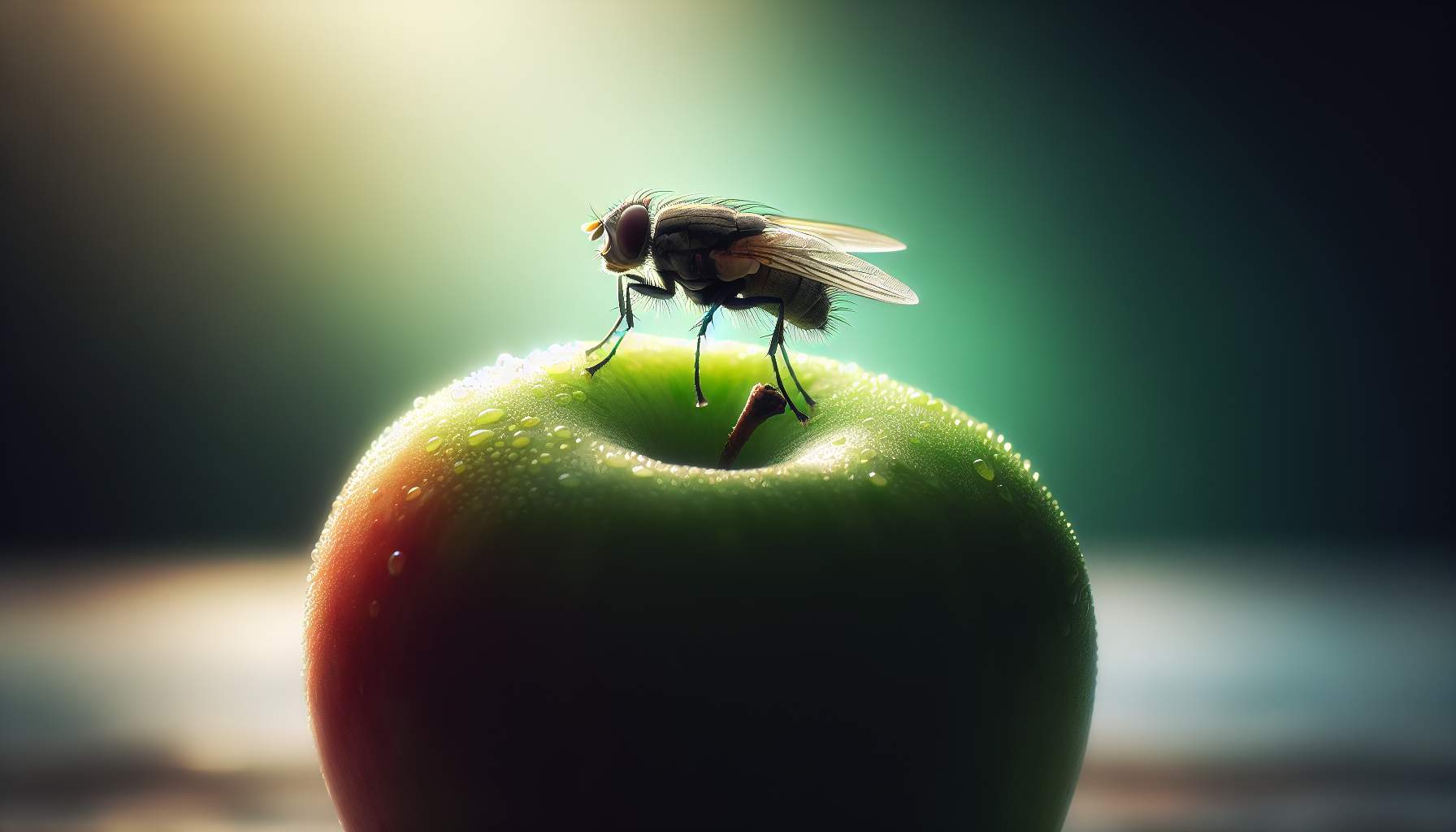For over a century, Drosophila melanogaster, commonly known as the fruit fly, has been at the forefront of scientific research, profoundly impacting genetics and developmental biology among other fields. In a recent conversation with Kristin Klueg, who serves as the Associate Director at The Drosophila Genomics Resource Center (DGRC), she unveiled some intriguing benefits of leveraging fruit flies for scientific studies and highlighted significant breakthroughs achieved through this research.
Fruit flies have emerged as an invaluable asset to scientists due to their remarkable genetic similarities with humans, making them ideal subjects to explore complex biological processes and diseases. Their short life cycle and ease of care further contribute to their appeal in laboratories worldwide. Through diligent study of these tiny creatures, researchers have unlocked key findings that offer profound implications for understanding human health and disease.
Kristin’s insights underscore the critical role that Drosophila melanogaster plays in propelling forward our comprehension of life’s intricacies. This ongoing journey into the microscopic world illuminates paths toward groundbreaking discoveries in medicine and beyond, proving once again how even the smallest beings can hold keys to vast scientific realms.
Could you provide some background information on the DGRC, including its founding date and its purpose?
In the dawn of the 2000s, a groundbreaking idea took shape within the realm of fruit fly research. The Drosophila community, a long-standing group led by dedicated scientists, recognized an urgent need for better access to genetic resources crucial for their studies. This realization was born out of discussions among faculty at Indiana University and other members of this specialized community. They identified that while numerous valuable genetic materials such as cDNA libraries were being produced, sharing these resources across labs was proving to be an onerous task.
To tackle this issue head-on, three visionary faculty members from Indiana University reached out to the National Institute of Health with a proposal that promised a solution. They envisioned creating a resource center with three main objectives: first, to serve as a repository for molecular and cellular tools; second, to facilitate the distribution of these materials within the Drosophila community; and third, to spearhead the adoption of cutting-edge technologies in their field.
Winning approval in 2003, this ambitious project led to the establishment of what is now known as the DGRC. From its inception, it was clear that this hub would play a pivotal role not just in collecting cDNA clones and vectors but also in seeking out cell lines desired by researchers and advancing microarray technology tailored for Drosophila study.
Fast forward over 17 years from its launch in 2004, and it’s evident that DGRC has far surpassed its initial goals amidst rapid technological advancements. What started with hopes of making around 5,000 to 10,000 cDNAs available has transformed into an invaluable asset for scientific exploration within this niche yet vital area of genetics research.
Describing your job in easy terms
Our platform serves a dual purpose, functioning both as a repository and a marketplace tailored specifically for the scientific community. Imagine us as an expansive digital library, where diverse resources are meticulously cataloged and preserved for future reference. This aspect of our service ensures that valuable scientific data and materials are safeguarded, much like precious books in a library.
Simultaneously, we embrace the role of an online store reminiscent of Amazon, but with a twist catered toward biologists. Our intuitive website features an easy-to-navigate interface where researchers can effortlessly browse through our extensive collection of scientific resources. With just a few clicks, they can add their desired items to their shopping cart and proceed to checkout, simplifying the process of acquiring essential research materials.
This innovative approach allows biologists to access what they need without hassles or delays — akin to shopping online for your favorite products but with the added benefit of advancing scientific discovery and knowledge. We pride ourselves on being at the intersection where convenience meets academia, providing an indispensable tool for scientists around the globe.
What makes fruit flies a common choice for genetic studies?
Long before the groundbreaking discovery of DNA, Drosophila, or the humble fruit fly, had already carved out its niche as a cornerstone in genetic research. For over a century, this small creature has been at the forefront of genetic studies due to several unique characteristics it possesses. With a rapid life cycle and visibly large chromosomes known as polytene chromosomes, Drosophila became an ideal candidate for genetic experimentation and analysis. Researchers have been able to pinpoint specific traits within these chromosomes with relative ease.
What sets Drosophila apart is not just its biological makeup but also the ethical simplicity it brings to research. Unlike experiments involving vertebrates that might raise ethical concerns, using fruit flies allows scientists to explore genetic mutations without much public outcry. This aspect significantly lowers barriers for conducting wide-ranging and repeated experiments essential for breakthroughs in genetics.
Perhaps one of its most monumental roles was serving as the pioneer organism for genome sequencing tests in the early 2000s. At that time, decoding an entire genome seemed like navigating uncharted waters with outdated maps—yet Drosophila proved it was possible. This success underscored its value beyond traditional genetic studies.
Today, Drosophila’s relevance continues unabated, especially when considering how closely its genes mirror those involved in human diseases. Remarkably, about 75% of genes associated with human health conditions are also present in Drosophila. This striking similarity makes it an invaluable model for unraveling disease mechanisms and exploring potential treatments.
In essence, through decades of rigorous scientific exploration and countless experiments, Drosophila has proven itself more than just a simple fruit fly—it’s a vital tool in our quest to understand complex genetic landscapes and tackle pressing health challenges.
Advantages of Choosing Fruit Flies Instead of Vertebrates for Research

Diving into the realm of genetics, Drosophila, commonly known as fruit flies, present an array of advantages for scientific research. Their brief lifespan stands out as a pivotal benefit. This feature allows researchers to observe genetic variations across multiple generations within a compact timeframe. The ability to swiftly create genetic combinations and introduce mutations with ease further accentuates their utility in laboratory studies.
In contrast, working with vertebrates such as mice or zebrafish introduces certain challenges. These organisms exhibit slower genetic cycles, significantly extending the duration required for experimental crosses. In practical terms, while you might accomplish numerous genetic experiments with Drosophila within a single year, vertebrate models would limit you to just a handful due to their prolonged life cycles.
Moreover, budget considerations cannot be overlooked. Maintaining Drosophila for research purposes proves to be cost-effective when compared to the expenses associated with raising vertebrates like mice or zebrafish in a lab setting.
In essence, opting for Drosophila in genetic studies offers scientists the efficiency and economic feasibility essential for advancing our understanding of genetics at an accelerated pace.
How has Drosophila research led to interesting discoveries?
Decoding the genetic blueprint of living organisms, particularly through genome sequencing, marked a revolution in biological sciences. This significant leap forward was exemplified by studies on the fruit fly, Drosophila, showcasing its capability for high-throughput sequencing. What makes this tiny creature so invaluable is its role as a mirror to human pathology – reflecting back at us our vulnerabilities to diseases such as cancer, Alzheimer’s, Parkinson’s, epilepsy, obesity, and heart disease.
The humble fruit fly has enabled scientists to fast-track our understanding of these conditions in ways that directly translate into advances in human medicine. This transfer of knowledge from insect to man isn’t just fascinating; it’s fundamentally changing how we approach disease treatment and prevention.
Enter CRISPR-Cas9, the groundbreaking gene-editing technology. Drosophila has been instrumental yet again, serving as a testing ground for refining CRISPR-Cas9 techniques. These experiments are not mere scientific curiosity but represent key steps towards employing gene editing in combating human diseases at their genetic roots. Through this lens, studying fruit flies doesn’t seem so small after all—it’s an endeavor with enormous implications for improving human health.
What current trends and technologies are you most enthusiastic about in your area of expertise?
At the cutting edge of medical innovation, CRISPR-Cas9 stands out as a beacon of hope. This gene-editing mechanism is garnering attention for its potential to revolutionize how we tackle diseases. Scientists worldwide are diving deep into its capabilities, making it a hotbed of promising new developments in biotechnology.
Meanwhile, an intriguing approach towards personalized medicine is making waves through the utilization of fruit flies (Drosophila) to explore treatments for rare human ailments. Vivan Therapeutics, previously known as My Personal Therapeutics, is pioneering this field by employing these tiny creatures in drug screening processes. The reality for individuals with rare forms of cancer is grim when it comes to large pharmaceutical companies investing in research—such efforts often don’t align with their financial goals due to the limited number of patients. However, by leveraging Drosophila’s genetic similarities to humans and inducing mutations, researchers can quickly sift through hundreds of drugs within months. This method offers a ray of hope in identifying effective treatments against uncommon cancers and diseases.
The essence here is that small startups are stepping up where big pharma falls short. They’re offering those diagnosed with rare conditions a fighting chance by pinpointing drug combinations that might just hit the mark using Drosophila models. It’s an innovative strategy that could drastically alter the landscape of treatment options for rare disease sufferers if further developed and embraced widely within scientific circles.
What future trends and innovations might emerge in your field?
Research on CRISPR-Cas9 technology is advancing, with dedicated teams diligently working to enhance its applications. This revolutionary genetic editing tool is being harnessed by researchers to modify Drosophila (fruit flies) for various scientific endeavors. By creating specialized tissue culture lines in these insects, scientists are not only pioneering new research avenues but also providing valuable resources for the broader scientific community.
Moreover, the usage of Drosophila extends beyond genetic research; it’s proving instrumental in drug discovery efforts aimed at tackling rare human diseases. The ability of these tiny creatures to serve as effective models for screening potential treatments is indeed groundbreaking.
Adding an intriguing twist to their versatility, Drosophila have caught the eye of researchers worldwide for a completely different reason: their potential as a sustainable food source. At a conference I attended some years back, there was considerable buzz around exploiting fruit flies’ high protein content as an innovative solution to combat global food insecurity.
In essence, the ongoing work with CRISPR-Cas9 and Drosophila spans from cutting-edge genetics to novel approaches in addressing pressing health and environmental issues—a testament to science’s endless possibilities when curiosity meets innovation.

















